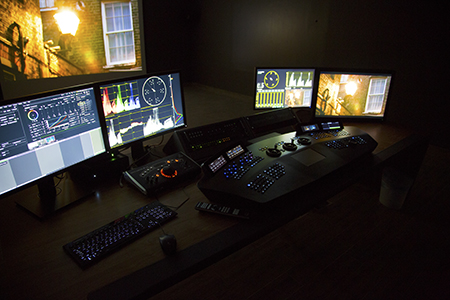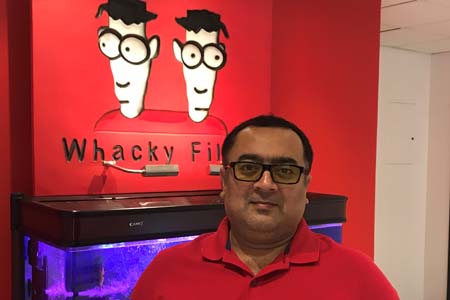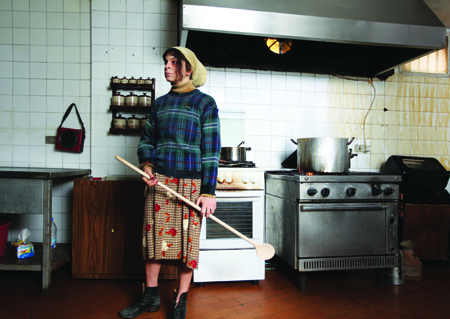The time-consuming and labour-intensive process of post-production is rarely appreciated and understood even less.
 While robots are editing movie trailers and plug-ins are automating the grading process, the deft skills of a manual colourist are not in danger of being usurped anytime soon. In fact, the skills of a colourist or for that matter a proficient rotoscoper, and the transformations he or she can engineer with the tools at hand, almost seem like magic for clients. Thats often part of the problem, says Kinjal Tanna, owner of KKDD Film Production LLC in Dubai.
While robots are editing movie trailers and plug-ins are automating the grading process, the deft skills of a manual colourist are not in danger of being usurped anytime soon. In fact, the skills of a colourist or for that matter a proficient rotoscoper, and the transformations he or she can engineer with the tools at hand, almost seem like magic for clients. Thats often part of the problem, says Kinjal Tanna, owner of KKDD Film Production LLC in Dubai.
The time-consuming and labour-intensive process of post-production is rarely appreciated and understood even less. Tanna elaborates: The basic challenge for a company like ours is getting a good post-production team set-up that will be able to manage the post and then educating the clients. A favourite theme among clients is lets just shoot and fix it in post. There are limitations with 3G, rotoscoping and other such magical technologies in terms of replicating or moving things and it is hugely time-consuming. For instance, three seconds of a particular movement that needs to be replicated is actually the mastering, cutting and moving of 75 frames.
After a six-year working break in Mumbai where he produced around 65 commercial films, Tanna has returned to his home base of Dubai with a revamped studio, KKDD Film Production LLC, that has facilities for both production and post-production. Apart from the occasional feature-length film, the company has been doing a lot of hair and skin commercials, with the films being shot in Bangkok and Mumbai for the Middle East market. And with clients that are increasingly price-sensitive, companies such as Tannas have come up with ingenious solutions.
A lot of times we end up doing rotoscoping for packs when clients say that the offer has changed or a pack design has changed. At times, we shoot using a plain hand. However, any movement of the hand makes the post-production work tricky. The main challenge is to explain to the client that we are not being difficult but there is a lot of work involved.
The issue with clients is echoed by Neelay Shah, Managing Director at Dejavu Fz LLC. Established in Dubai in 2007, Dejavu has won prestigious awards, including two Bronze Lions at Cannes. While it began as a post-production company centred around editing and visual effects, films followed, and today the company has more than 50 staff and offices in Dubai, Beirut and Mumbai.
To sustain a business, you need to combine production with post-production, asserts Shah.As a production house, it gives us an edge. With your own post-production department, you can absorb extra costs while quoting. It also adds to flexibility when it comes to time in case the deadlines are tight, which is pretty often, he says.
As a fee-for-service business with razor-thin profit margins, production houses also face rising staff and capital costs. And then theres competition from start-ups to contend with. In this scenario, production houses fight to retain customers and talent alike.
One of the key issues for companies such as KKDD and Dejavu is to get the right clients and then manage them, a proposition that might sound simple but has a lot of dynamic issues, says Shah: With a fixed price quoting system and work that rarely gets done in the allocated budget and time, clients do not want to pay for extra hours that are put in.
With a portfolio that boasts some of the biggest telcos in the region and sporting franchises in South Asia, he adds: The ideal scenario for production companies is to have high-margin clients who offer return business. In order to attract them, you need to position yourself to be the best in your niche.
Post-production work at Dejavu covers the entire spectrum, from the Adobe suite of solutions for editing and DaVinci Resolve for colour grading, to 2D, rotoscoping, VR-related work and other immersive platforms. For audio, the company works with partners depending on the nature of the job and country they are operating in.
The audio and the visual have to speak the same language however, working with different audio partners ensures your work does not all sound the same, says Shah. With a movie such as Mamma Mia reportedly having more than 900 shots requiring special effects treatment, the production pipeline is an increasingly demanding place. This is exacerbated by clients who often cannot pinpoint what they need, requiring multiple re-rendering or re-formatting.
Tanna, Shah and other professionals in the business bemoan the excessive involvement of the regional client to the detriment of the project. The creatives word needs to be respected and trusted to deliver for the brand, stresses Shah. At times, you have clients who want to have a say on every frame of the film.
On running a post-production facility in Dubai, Aiham Ajib, CEO and Creative Director of Real Image, says: Dubais post-production industry is generally no different than anywhere else. Keeping our heads above water is probably the most challenging. Our projects come in peaks and troughs, so cash flow is always an issue. We also find that many clients do not really abide by payment terms and that is very stressful on the business. Budgets are ever-shrinking, so are the deadlines, but our clients want more so we are constantly learning to work faster and better.
Founded in 1996 in Dubai, Real Image is a well-known name in animation and post-production. The company regularly wins plaudits, including a BroadcastPro ME award, for its visually innovative work.
Giving an overview of the company, Ajib says: Most of our post-production services are for in-house projects, as our clients generally engage us as an agency that provides video content solutions. We have a staff size of 45 people, including 20 artists who are specialised in VFX, CGI, motion graphics and traditional animation. We also have a corporate video film production department. Together with our digital compositing team and editing facilities, we have a wide spectrum of creative tools to pick from to develop our video proposals.
Outlining the solutions the company offers, Ajib says: We have four FCP edit suites and a Smoke suite. We also use DaVinci Resolve as an editing tool and a separate DaVinci Resolve studio system for colour grading. For CGI, our 3D and VFX artists use Maya, while the motion graphics artists prefer Cinema 4D.
For digital compositing, its mostly up to the artists, typically it is Nuke, AE and Fusion. Our rotoscoping and tracking department also uses a range of products, from Nuke, Fusion, Mocha and recently Flowbox. Our traditional animators stay traditional, sometimes working on paper and then transferring to Adobe Flash. For architectural visualisation, we use Max.
We are equipped with one of the most powerful render farms in the region, but we also have a dedicated GPU-based computer using the Redshift rendering system. This has come in handy for a lot of the motion graphics work which require fast previsualisation.
The one-stop service approach is a common feature most post-production houses are also production houses, or the other way around. Explaining this phenomenon, Tanna says: In other parts of the world, you have specialised post. Dubai is a very competitive market, and for me to be viable, I need to have offline, online and grading in-house. It helps me save cost and gives me a competitive edge.
Comparing the region with bigger, more established markets, Tanna observes: When you have a market like India where you have so many feature films and shows being made, an average production studio will have four to five offline suites, five to seven online suites, two grading suites the scope of work justifies it. Here we do not have that volume of work to justify having a stand-alone post-production house.
There is an amazing amount of work to be done in Dubai, though, he stresses. A lot of the work has shifted to digital. We have clients who have two-week campaigns and they are not looking at a typical $200,000 commercial that will run for six months; they would rather spend 10-15% of that budget for a short period of time.
Tanna revamped an existing studio and upgraded everything, from Pro Tools and Final Cut Pro (FCP) to the DaVinci Resolve software. We did a couple of hardware upgrades as well. Today we work on the latest FCP and Adobe platforms. We are fully geared to handle all types of post-production and CG, along with lip sync, radio commercials, jingles, music composition, language dubbing facilities and so on. For colour grading, we have Da Vinci Resolve.
With skill shortages, rising rent and increased competition among the big concerns, companies are minimising their physical footprint with concepts such as pop-up post houses and remote post-production. Earlier this year, KKDD Film Production became the first regional company to successful attempt remote colour grading on DaVinci Resolve, with colourists in Mumbai post-production company Nube Studio.
Kinjal recalls: We worked on a TV commercial. The company in Mumbai uploaded the files with no conversion or generation loss. We had to upload the XML files along with the rushes of the film. Other than having the same XML files and offline edit footage, the timelines also had to coincide perfectly.
Whereas previously Tannas team would have sent reference files to the colourist in Mumbai for the inevitable back and forth before final approvals, the real-time grading allowed them to achieve their outcome with no loss of control.
Remote grading increases our reach and gives us the benefit of working with different colourists around the world. We are not restricted anymore, having ironed out the technical issues, he says.
The incessant pace of rising sophistication in video post-production has been made more complex by different digital camera technologies. New compression formats, 4K mastering and growing content libraries have not made it easier. Also, with the exponential rise in viewers watching 480p content on smartphones, production houses have to accommodate a wide range of resolutions, formats and codecs to keep up with consumer viewing preferences.
A recent project Shahs team worked on highlight workflow complexities. We just did a brand campaign for a regional telco. It was shot in four countries with five cameras. There was a lot of footage, images and time lapses. In addition, on the ground we were collaborating with local crew in those respective countries. We had to deal with footage from Alexa film cameras, digital cameras and still cameras. To manage, assemble and edit the footage was quite challenging.
But he keeps going despite perennial issues around budgets and micromanaging clients and agencies: We do enjoy the adrenaline rush of working to create the best work under deadlines and other constraints.
Acknowledging these constraints, Ajib of Real Image says: There is not a single film weve done that didnt come with challenges. The thing is, we create our own briefs and were always trying to outdo the project we had done before which is like challenging yourself to constantly do more and do better.




































































